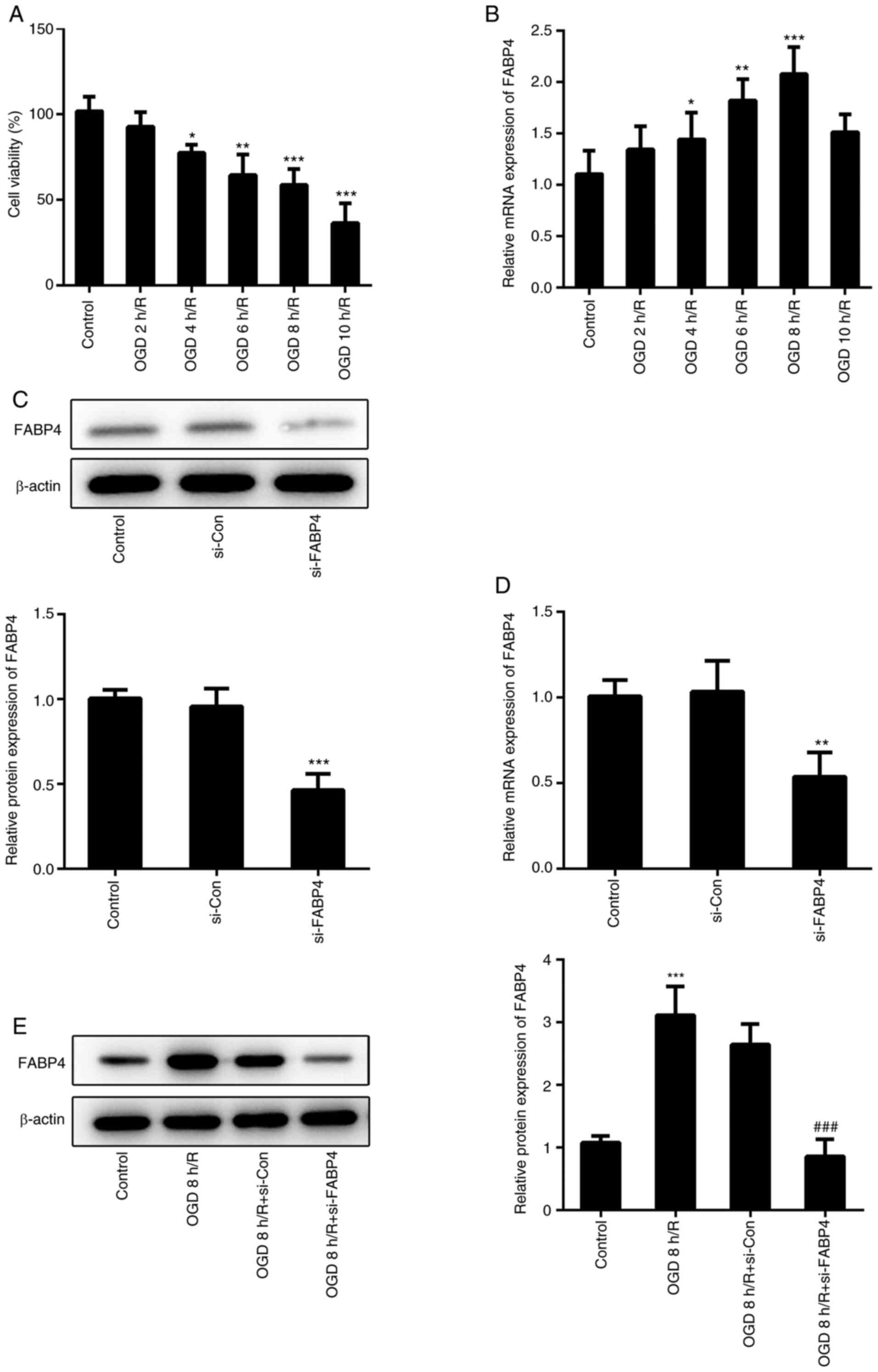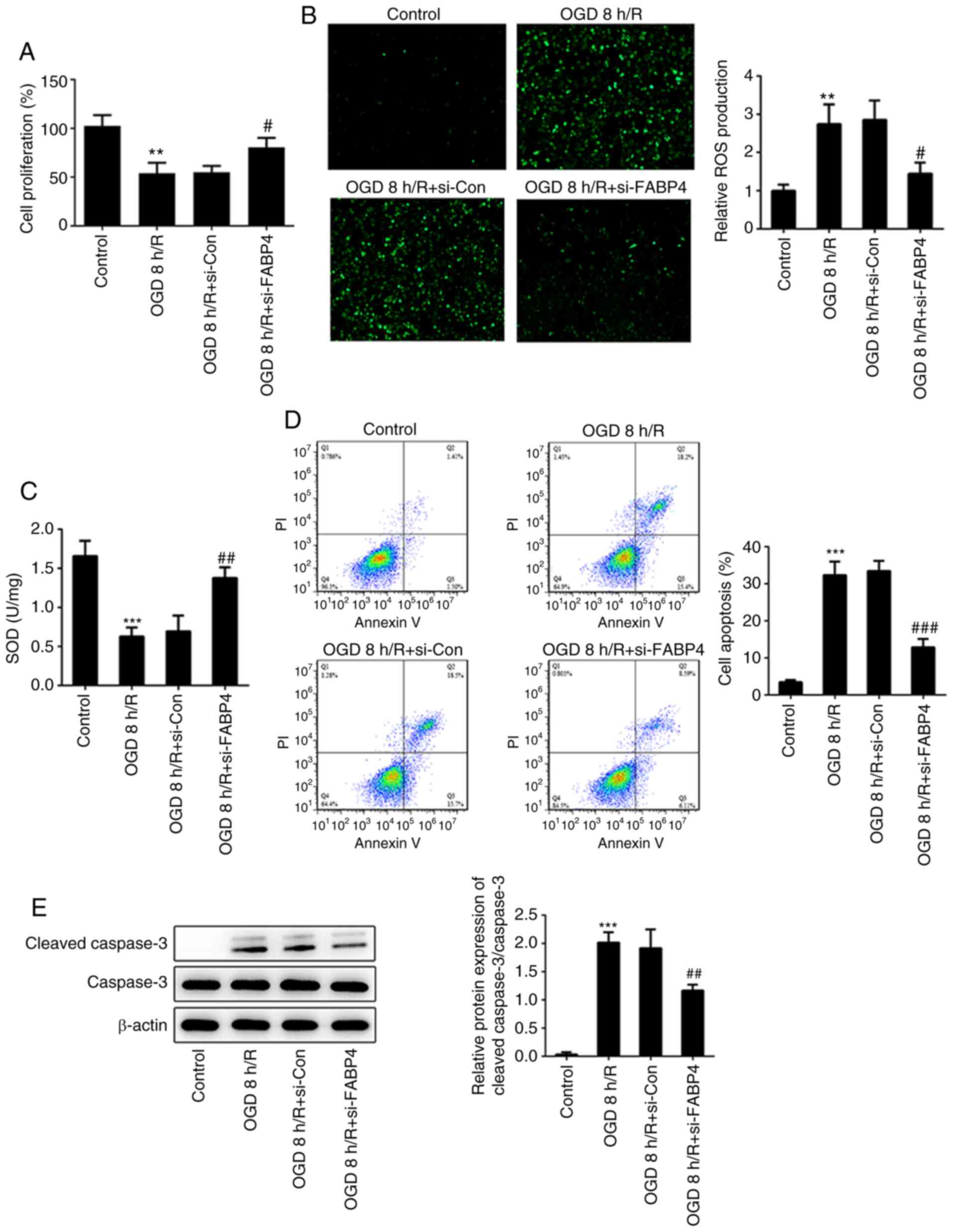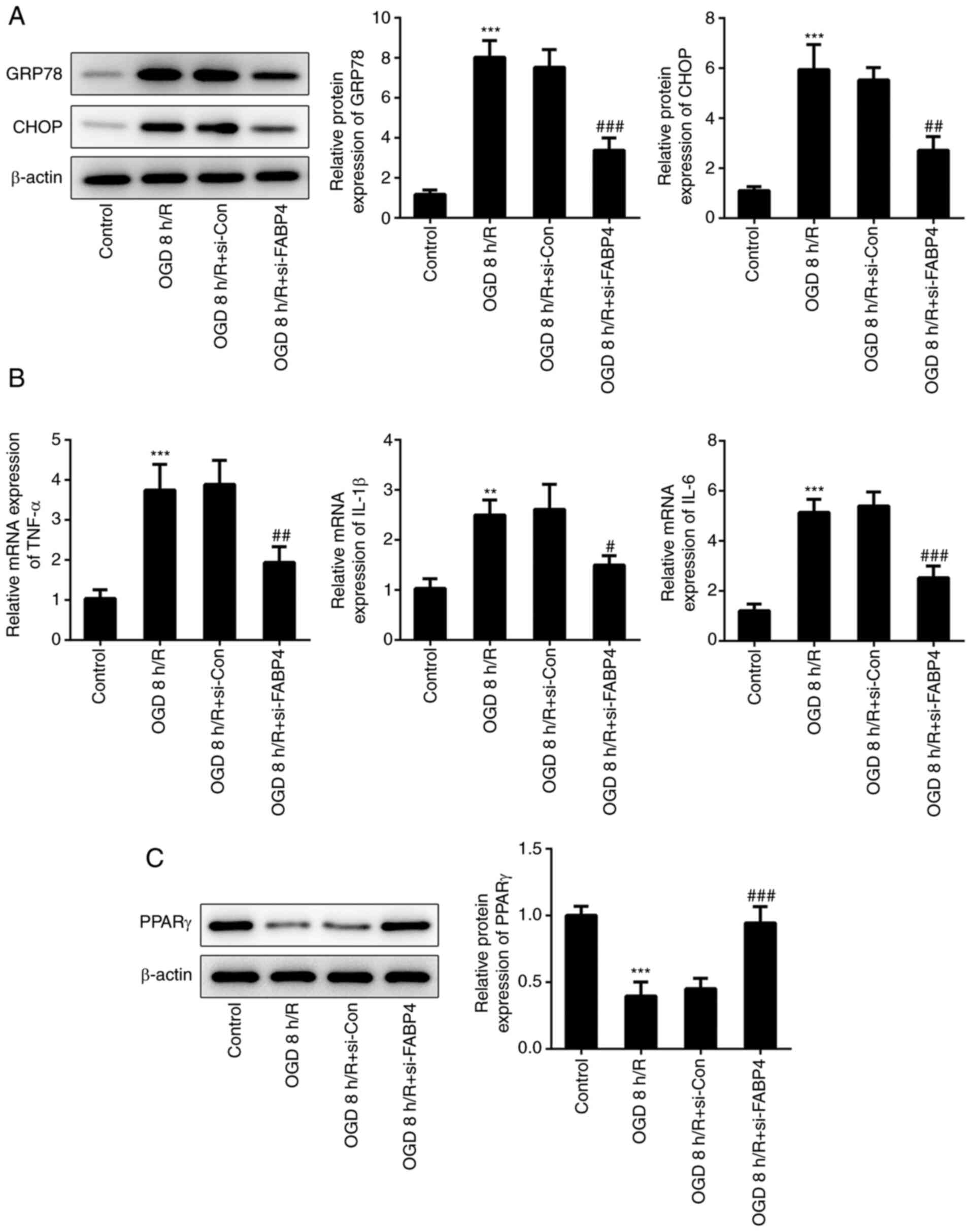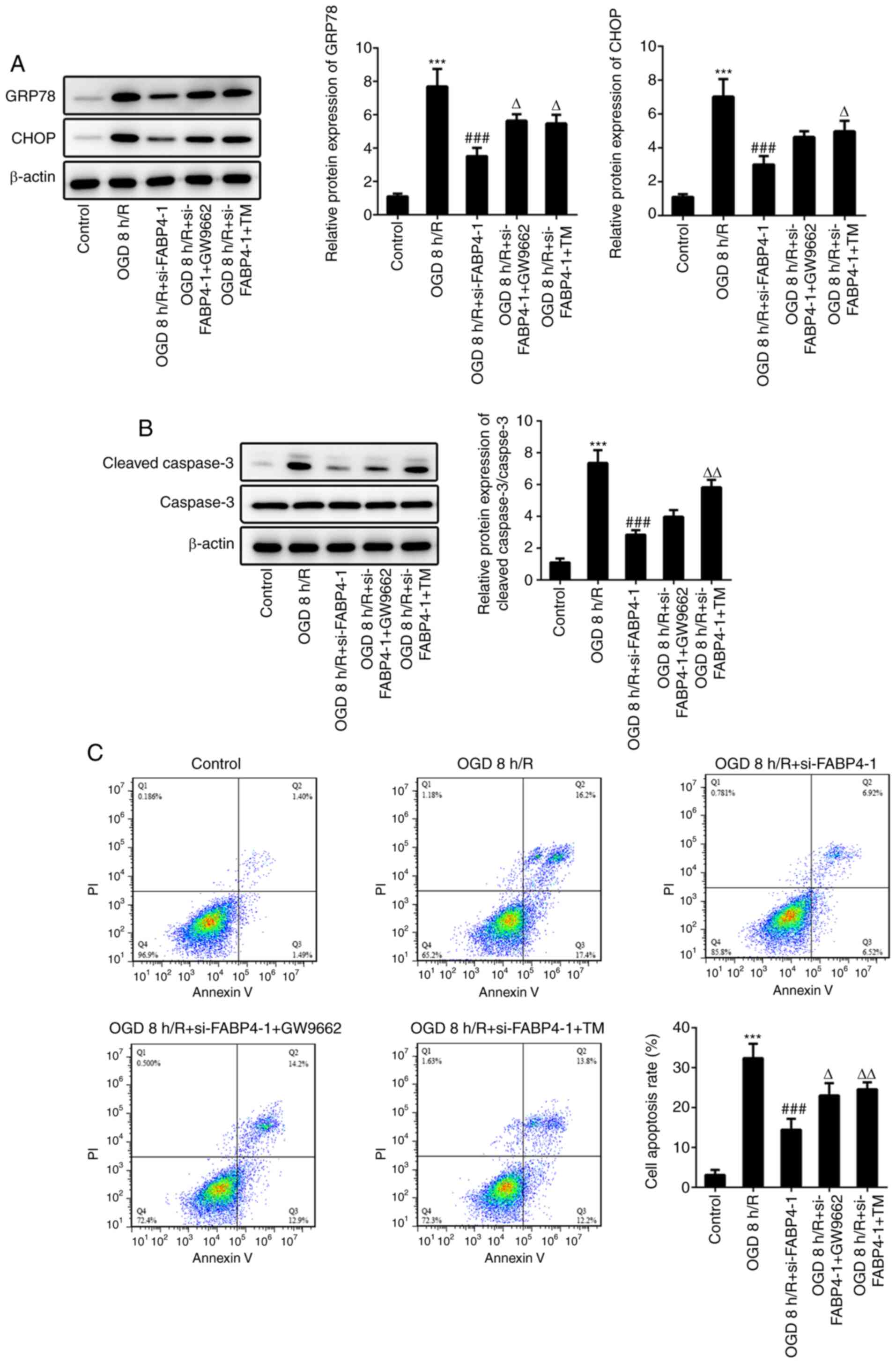FABP4 alleviates endoplasmic reticulum stress‑mediated ischemia‑reperfusion injury in PC12 cells via regulation of PPARγ
- Authors:
- Published online on: January 5, 2021 https://doi.org/10.3892/etm.2021.9612
- Article Number: 181
-
Copyright: © Yang et al. This is an open access article distributed under the terms of Creative Commons Attribution License.
Abstract
Introduction
As the leading cause of mortality and disability worldwide, stroke refers to cerebral vascular injury, local or whole brain tissue damage caused by various reasons, resulting in clinical symptoms for >24 h or sudden death (1,2). Stroke is commonly classified into two categories, ischemic stroke (cerebral infarction) and hemorrhagic stroke (parenchymal hemorrhage, intraventricular hemorrhage and subarachnoid hemorrhage), of which ischemic stroke accounts for ~80% (3,4). To date, few drugs have been approved for the treatment of ischemic stroke (5), and there is still considerable capacity and demand for the development of effective drugs to cure ischemic stroke. An improved understanding of the pathophysiology of ischemic stroke could provide basis for clinical research.
Cerebral ischemia-reperfusion (I/R) injury is generally considered as a complex pathophysiological process of ischemic stroke (6). Cerebral ischemia initiates a series of cascades, including inflammation, followed by the production of reactive oxygen species (ROS) and apoptosis, which aggravate the damage of brain cells, destroy the extracellular matrix and blood-brain barrier (7).
FABPs are lipid-binding chaperones that are expressed in various tissue types. FABPs may regulate the transport of fat, promote the formation of blood vessels and cell differentiation, and participate in the occurrence of various metabolic diseases (8-10). FABP4 participates in ERS and inflammation, contributing toward the release of inflammatory cytokines (11,12). FABP4 protects the kidney from I/R-induced acute kidney injury (13). A recent study has demonstrated that FABP4 may be a novel therapeutic target for hepatic I/R injury (14). In addition, high levels of FABP4 in plasma were associated with poor prognosis in patients with acute ischemic stroke (15). However, the role of FABP4 in cerebral I/R injury has rarely been investigated. Therefore, the aim of the present study was to investigate the function of FABP4 in the pathogenesis of ischemic stroke. The PC12 cell line is a differentiated cell line of rat adrenal medulla pheochromocytoma. It is widely used in neurophysiological and neuropharmacological research because it possesses the general characteristics of neuroendocrine cells and can be passaged. In the present study, PC12 cells were selected to establish an OGD/R model in vitro.
Materials and methods
Cell culture
PC12 cell line (Type Culture Collection of the Chinese Academy of Sciences) were cultured in Dulbecco's modified Eagle's medium (DMEM; Gibco; Thermo Fisher Scientific, Inc.) supplemented with 10% fetal bovine serum (FBS) at 37˚C in an atmosphere of 5% CO2. Cells were transfected with 10 µM FABP4 small interfering RNA (siRNA; Santa Cruz Biotechnology, Inc.) or negative control siRNA using Lipofectamine 2000 (Thermo Fisher Scientific, Inc.), according to the manufacturer's protocol. A total of 6 h post-transfection, fresh DMEM, supplemented with 10% fetal bovine serum, was replaced, followed by incubation for 48 h. GW9662 (MedChemExpress Co., Ltd.), a selective PPARγ antagonist was used to treat cells 2 h prior to OGD/R. ERS agonist tunicamycin (MedChemExpress Co., Ltd.) was obtained to incubate cells 2 h prior to OGD/R to induce ERS.
OGD/R model
PC12 cells that have been exposed to OGD/R have been widely used to simulate cerebral I/R injury in vitro (16,17). Cells were maintained in a glucose-deprivation buffer (Gibco; Thermo Fisher Scientific, Inc.) and incubated in an anaerobic chamber in an atmosphere of 95% N2/5% CO2 for 2, 4, 6, 8 or 10 h, followed by fresh DMEM (containing 10% fetal bovine serum) under normoxic conditions with 95% air/5% CO2 for 24 h.
CCK-8 assay
PC12 cells were resuspended in culture medium and then planted onto a 96-well plate (5x103 cells per well). Following reoxygenation for 2, 4, 6, 8 or 12 h, 10 µl CCK-8 reagent (MedChemExpress Co., Ltd.) was added to each well and incubated for 2 h. Subsequently, the absorbance value of each well was recorded using a microplate reader (BioTek Instruments, Inc.) at 450 nm wavelength.
Reverse transcription-quantitative polymerase chain reaction (RT-qPCR)
TRIzol reagent (Invitrogen; Thermo Fisher Scientific, Inc.) was used to extract total RNA from PC12 cells. The PrimeScript RT reagent kit (Takara Biotechnology, Inc.) was used for reverse transcription of RNA (42˚C for 30 min; 99˚C for 5 min). Amplification reaction was performed using SYBR-Green PCR kit (Qiagen, Inc.) and subjected to Applied Biosystems 7500 system (Applied Biosystems; Thermo Fisher Scientific, Inc.). The primer sequences were listed as follows: FABP4 sense, 5'-GCCAGGAATTTGACGAAGTCAC-3' and antisense, 5'-TTCTGCACATGTACCAGGACAC-3'; IL-6 sense, 5'-ATTGTATGAACAGCGATGATGCAC-3' and antisense, 5'-CCAGGTAGAAACGGAACTCCAGA-3'; IL-1β sense, 5'-CCCTGAACTCAACTGTGAAATAGCA-3' and antisense, 5'-CCCAAGTCAAGGGCTTGGAA-3'; TNF-α sense, 5'-TCAGCCTCTTCTCATTCCTGC-3' and antisense, 5'-TTGGTGGTTTGCTACGACGTG-3'; β-actin sense, 5'-GGAGATTACTGCCCTGGCTCCTA-3' and antisense, 5'-GACTCATCGTACTCCTGCTTGCTG-3'. β-actin served as an endogenous control. PCR reaction conditions were as follows: 95˚C for 2 min, followed by 40 cycles of 95˚C for 20 sec and 65˚C for 40 sec. Expression levels of target genes were analyzed using the 2-ΔΔCq method (18).
Cell apoptosis assay
A total of 1x106/ml PC12 cells were collected and apoptosis was detected by double staining with fluorescein isothiocyanate (FITC)-Annexin V and propidium iodide (PI) for 10 min in the dark at room temperature. Subsequently, cells were subjected to a FACSCalibur flow cytometer (BD Biosciences) to detect the apoptotic rate. Data were analyzed using flow cytometry software (iSort™ Automated Cell Sorter; version A.0; Thermo Fisher Scientific, Inc.).
Western blotting
Total protein was extracted from PC12 cells using RIPA lysis buffer (Beyotime Institute of Biotechnology). Following centrifugation for 10 min at 4˚C (12,000 x g), cell supernatant was collected and the protein concentration was estimated using a BCA assay kit (Beyotime Institute of Biotechnology). A total of 20 µg protein per lane was separated by 10% SDS-PAGE gel and transferred onto PVDF membranes. Membranes were blocked with 5% skimmed milk at room temperature for 2 h followed by incubation with primary antibodies at 4˚C overnight. FABP4 (1:5,000; cat. no. ab92501), cleaved-caspase-3 (1:500; cat. no. ab49822) and caspase-3 (1:2,000; cat. no. ab184787) antibodies were obtained from Abcam, GRP78 (1:1,000; cat. no. sc-13539) and CHOP (1:1,000; cat. no. sc-7351) antibodies were purchased from Santa Cruz Biotechnology, Inc. β-actin (1:5,000; A1978) antibody was obtained from Sigma-Aldrich (Merck KGaA). Horseradish peroxidase-conjugated goat anti-rabbit IgG (1:5,000; cat. no. ab6721; Abcam) and goat anti-mouse IgG secondary antibodies (1:5,000; cat. no. ab6789; Abcam) were used for detection (room temperature; 2 h). The protein bands were visualized with an Enhanced Chemiluminescence Detection kit (Thermo Fisher Scientific, Inc.). Protein expression levels were semi-quantified using Image-Pro Plus software version 6.0 (Roper Technologies, Inc.).
Determination of ROS
The production of ROS was estimated using a ROS assay kit (Beyotime Institute of Biotechnology). PC12 cells (5x106 cells/ml) were collected and suspended in the diluted DCFH-DA (probe) at a final concentration of 10 µM. Next, cells were incubated at 37˚C for 20 min and mixed every 5 min to enable the probe to be in full contact with the cells. The cells were washed three times with DMEM, and ROS was determined at wavelengths of 488 and 525 nm using a fluorescence microplate reader (Omega Bio-Tek, Inc.).
The measurement of SOD activity
SOD activity was determined using an SOD assay kit (Beyotime Institute of Biotechnology). In brief, SOD sample preparation solution was used to lyse PC12 cells, and the solution was centrifugated for 5 min at 4˚C (12,000 x g) to collect cell supernatant. Corresponding solution was added for 30 min at 37˚C and the absorbance value was recorded using a microplate reader (Omega Bio-Tek, Inc.) at 450 nm wavelength.
Statistical analysis
All the experiments were performed in triplicate and results are expressed as the mean ± standard deviation of data from triplicate experiments. A t-test or one-way analysis of variance followed by Tukey's test was used for comparisons between two groups or multiple groups, respectively. P<0.05 was considered to indicate a statistically significant difference.
Results
Downregulation of FABP4 in PC12 cells under OGD/R
PC12 cells subjected to 2, 4, 6, 8 or 10 h OGD, respectively, followed by 24 h reoxygenation. As shown in Fig. 1A, prolonged duration of OGD led to a decrease in cell activity. The expression of FABP4 in PC12 cells exposed to OGD/R was gradually increased, which matched the decrease in cell viability. However, FABP4 was downregulated when cells were exposed to OGD for 10 h, compared with OGD for 8 h, which may involve several underlying mechanisms (Fig. 1B). Therefore, OGD for 8 h and reoxygenation for 24 h served as an invariant OGD/R condition for subsequent experiments. PC12 cells under normal conditions were transfected with FABP4 siRNA, and the transcription and translation of FABP4 was significantly decreased (Fig. 1C and D). Additionally, FABP4 siRNA decreased the protein expression of FABP4 under OGD/R (Fig. 1E). Furthermore, FABP4 was downregulated in PC12 cells exposed to OGD/R.
FABP4 knockdown inhibits oxidative stress and apoptosis
Oxidative stress is the main event in the pathogenesis of I/R injury (19). The present study demonstrated that OGD/R inhibited cell proliferation and induced a potent increment of ROS production. FABP4 siRNA caused a significant increase in cell proliferation and decrease in the ROS level, compared with control siRNA under OGD/R (Fig. 2A and B). On the other hand, the decrease in SOD activity under OGD/R, compared with the control group, demonstrated that oxidative stress occurred under OGD/R conditions (Fig. 2C). Apoptotic rates of PC12 cells under different conditions were determined by flow cytometry. OGD/R induced marked cell apoptosis, while FABP4 siRNA potently decreased the apoptotic rate (Fig. 2D). Furthermore, increased cleaved caspase-3 under an OGD/R and FABP4 knockdown-mediated decrease in cleaved caspase-3 under OGD/R further suggested an anti-apoptotic effect of FABP4-knockdown (Fig. 2E). Therefore, FABP4 siRNA protected PC12 cells against OGD/R-induced oxidative stress and apoptosis.
Interference of FABP4 suppresses inflammation, ERS and activated PPARγ
A recent study illustrated that FABP4 regulated the apoptosis of tubular epithelial cells via inactivating ERS (20). ERS is generally considered to contribute toward neuronal apoptosis following cerebral IR (21). ERS-related proteins, GRP78 and CHOP, were enhanced under OGD/R (Fig. 3A), accompanied by upregulation of inflammatory factors TNF-α, IL-1β and IL-6 (Fig. 3B). Notably, FABP4 siRNA alleviated OGD/R-induced ERS and inflammation. Activation of PPARγ may protect the brain from cerebral I/R injury via inhibiting ERS (22). As shown in Fig. 3C, the protein expression of PPARγ was markedly decreased under OGD/R; however, it was reinforced in PC12 cells transfected with FABP4 siRNA. Taken together, these finding suggested that FABP4 siRNA repressed inflammation, ERS and activated PPARγ under OGD/R.
FABP4 modulates ERS and apoptosis via regulation of PPARγ
PPARγ antagonist GW9662 was employed in subsequent experiments to further investigate the role of PPARγ in FABP4-mediated ERS and apoptosis. The levels of GRP78 and CHOP were decreased following transfection with FABP4 siRNA under OGD/R. GW9662 reversed the function of FABP4 siRNA, showing a similar result to the ERS agonist, tunicamycin (Fig. 4A). Cleaved caspase-3 was decreased in PC12 cells transfected with FABP4 siRNA, compared with that of the OGD/R group, and cleaved caspase-3 in cells treated with GW9662 or tunicamycin on the basis of FABP4 siRNA transfection was increased, compared with FABP4 siRNA transfection only (Fig. 4B). Furthermore, apoptotic rates of PC12 cells indicated that the anti-apoptotic effects of FABP4 siRNA were abolished by GW9662 or tunicamycin (Fig. 4C). These results implied that PPARγ involved FABP4-regulated ERS and apoptosis.
Discussion
Cerebral I/R injury is a core pathophysiological process of ischemic stroke (6). FABP4 has been investigated in I/R injury of the kidney, liver and myocardium (13,14,23). The roles of FABP4 in cerebral I/R injury are largely unknown. In the present study, cerebral I/R injury was simulated in vitro to investigate the effects of FABP4 in PC12 cells under OGD/R conditions.
During 8 h of OGD, cell viability was gradually downregulated and FABP4 was gradually increased, suggesting that FABP4 had a harmful effect on PC12 cells under OGD/R conditions, which was consistent with the results reported in myocardial IR injury (23). Oxidative stress and inflammation serve as the main pathogenesis of I/R injury, and effective prevention of oxidative stress and inflammation is conducive to ameliorate I/R injury (24). In the present study, FABP4-silencing decreased the expression of inflammatory factors, IL-1β, IL-6 and TNF-α, and the decrease in ROS and increase in SOD demonstrated that FABP4 siRNA relieved oxidative stress.
Bosquet et al (25) reported that exogenous FABP4 promoted ERS in HepG2 cells. In addition, another study reported by Bosquet et al (26) described that the FABP4 inhibitor prevented lipid-induced ERS-associated inflammation in skeletal muscle. The present study demonstrated that FABP4-silencing ameliorated ERS and ERS-associated apoptosis. ERS contributes toward the development of cerebral I/R injury (25).
PPARγ accelerated the elimination of additional superoxide by promoting the transcription of SOD. Inhibition of PPARγ promoted neuron apoptosis in ischemia by upregulating ROS scavenging genes (26). FABP4 siRNA repressed inflammation and enhanced PPARγ signaling in proximal tubular epithelial cells (27). In PC12 cells, FABP4 siRNA contributed toward the increase in PPARγ expression. The PPARγ antagonist, GW9662, counteracted the effects of FABP4 siRNA on ERS and apoptosis.
In summary, the present study demonstrated that FABP4 was overexpressed in PC12 cells under OGD/R, and FABP4-silencing inhibited ERS-associated inflammation, oxidative stress and apoptosis via upregulating PPARγ signaling.
Acknowledgements
Not applicable.
Funding
No funding was received.
Availability of data and materials
All data generated or analyzed during this study are included in this published article.
Authors' contributions
XLY performed the experiments and drafted the manuscript, JHM analyzed and interpreted the data and QD designed the study. All authors read and approved the final manuscript.
Ethics approval and consent to participate
Not applicable.
Patient consent for publication
Not applicable.
Competing interests
The authors declare that they have no competing interests.
References
|
Khoshnam SE, Winlow W, Farzaneh M, Farbood Y and Moghaddam HF: Pathogenic mechanisms following ischemic stroke. Neurol Sci. 38:1167–1186. 2017.PubMed/NCBI View Article : Google Scholar | |
|
Siniscalchi A, Gallelli L, Malferrari G, Pirritano D, Serra R, Santangelo E and De Sarro G: Cerebral stroke injury: The role of cytokines and brain inflammation. J Basic Clin Physiol Pharmacol. 25:131–137. 2014.PubMed/NCBI View Article : Google Scholar | |
|
Tobin MK, Bonds JA, Minshall RD, Pelligrino DA, Testai FD and Lazarov O: Neurogenesis and inflammation after ischemic stroke: What is known and where we go from here. J Cereb Blood Flow Metab. 34:1573–1584. 2014.PubMed/NCBI View Article : Google Scholar | |
|
Kim JY, Kawabori M and Yenari MA: Innate inflammatory responses in stroke: Mechanisms and potential therapeutic targets. Curr Medb Chem. 21:2076–2097. 2014.PubMed/NCBI View Article : Google Scholar | |
|
Blakeley JO and Llinas RH: Thrombolytic therapy for acute ischemic stroke. J Neurol Sci. 261:55–62. 2007.PubMed/NCBI View Article : Google Scholar | |
|
Fu Y, Liu Q, Anrather J and Shi FD: Immune interventions in stroke. Nat Rev Neurol. 11:524–535. 2015.PubMed/NCBI View Article : Google Scholar | |
|
Danton GH and Dietrich WD: Inflammatory mechanisms after ischemia and stroke. J Neuropathol Exp Neurol. 62:127–136. 2003.PubMed/NCBI View Article : Google Scholar | |
|
Bogdan D, Falcone J, Kanjiya MP, Park SH, Carbonetti G, Studholme K, Gomez M, Lu Y, Elmes MW, Smietalo N, et al: Fatty acid-binding protein 5 controls microsomal prostaglandin E synthase 1 (mPGES-1) induction during inflammation. J Biol Chem. 293:5295–5306. 2018.PubMed/NCBI View Article : Google Scholar | |
|
Yu CW, Liang X, Lipsky S, Karaaslan C, Kozakewich H, Hotamisligil GS, Bischoff J and Cataltepe S: Dual role of fatty acid-binding protein 5 on endothelial cell fate: A potential link between lipid metabolism and angiogenic responses. Angiogenesis. 19:95–106. 2016.PubMed/NCBI View Article : Google Scholar | |
|
Rodriguez Sawicki L, Bottasso Arias NM, Scaglia N, Falomir Lockhart LJ, Franchini GR, Storch J and Córsico B: FABP1 knockdown in human enterocytes impairs proliferation and alters lipid metabolism. Biochim Biophys Acta Mol Cell Biol Lipids. 1862:1587–1594. 2017.PubMed/NCBI View Article : Google Scholar | |
|
Hotamisligil GS and Bernlohr DA: Metabolic functions of FABPs-mechanisms and therapeutic implications. Nat Rev Endocrinol. 11:592–605. 2015.PubMed/NCBI View Article : Google Scholar | |
|
Chen Y, Gao H, Yin Q, Chen L, Dong P, Zhang X and Kang J: ER stress activating ATF4/CHOP-TNF-α signaling pathway contributes to alcohol-induced disruption of osteogenic lineage of multipotential mesenchymal stem cell. Cell Physiol Biochem. 32:743–754. 2013.PubMed/NCBI View Article : Google Scholar | |
|
Shi M, Huang R, Guo F, Li L, Feng Y, Wei Z, Zhou L, Ma L and Fu P: Pharmacological inhibition of fatty acid-binding protein 4 (FABP4) protects against renal ischemia-reperfusion injury. Rsc Advances. 8:15207–15214. 2018.PubMed/NCBI View Article : Google Scholar | |
|
Hu B, Guo Y, Garbacz WG, Jiang M, Xu M, Huang H, Tsung A, Billiar TR, Ramakrishnan SK, Shah YM, et al: Fatty acid binding protein-4 (FABP4) is a hypoxia inducible gene that sensitizes mice to liver ischemia/reperfusion injury. J Hepatol. 63:855–862. 2015.PubMed/NCBI View Article : Google Scholar | |
|
Holm S, Ueland T, Dahl TB, Michelsen AE, Skjelland M, Russell D, Nymo SH, Krohg-Sørensen K, Clausen OP, Atar D, et al: Fatty acid binding protein 4 is associated with carotid atherosclerosis and outcome in patients with acute ischemic stroke. PLoS One. 6(e28785)2011.PubMed/NCBI View Article : Google Scholar | |
|
Li TF, Ma J, Han XW, Jia YX, Yuan HF, Shui SF, Guo D and Yan L: Chrysin ameliorates cerebral ischemia/reperfusion (I/R) injury in rats by regulating the PI3K/Akt/mTOR pathway. Neurochem Int. 129(104496)2019.PubMed/NCBI View Article : Google Scholar | |
|
Jiang D, Sun X, Wang S and Man H: Upregulation of miR-874-3p decreases cerebral ischemia/reperfusion injury by directly targeting BMF and BCL2L13. Biomed Pharmacother. 117(108941)2019.PubMed/NCBI View Article : Google Scholar | |
|
Whiley H and Taylor M: Legionella detection by culture and qPCR: Comparing apples and oranges. Crit Rev Microbiol. 42:65–74. 2016.PubMed/NCBI View Article : Google Scholar | |
|
Zhang HF, Li TB, Liu B, Lou Z, Zhang JJ, Peng JJ, Zhang XJ, Ma QL, Peng J and Luo XJ: Inhibition of myosin light chain kinase reduces NADPH oxidase-mediated oxidative injury in rat brain following cerebral ischemia/reperfusion. Naunyn Schmiedebergs Arch Pharmacol. 388:953–963. 2015.PubMed/NCBI View Article : Google Scholar | |
|
Tan Z, Guo F, Huang Z, Xia Z, Liu J, Tao S, Li L, Feng Y, Du X, Ma L and Fu P: Pharmacological and genetic inhibition of fatty acid-binding protein 4 alleviated cisplatin-induced acute kidney injury. J Cell Mol Med. 23:6260–6270. 2019.PubMed/NCBI View Article : Google Scholar | |
|
Yang W and Paschen W: Unfolded protein response in brain ischemia: A timely update. J Cereb Blood Flow Metab. 36:2044–2050. 2016.PubMed/NCBI View Article : Google Scholar | |
|
Chen Y, Liu S and Chen G: Aggravation of cerebral ischemia/reperfusion injury by peroxisome proliferator-activated receptor-gamma deficiency via endoplasmic reticulum stress. Med Sci Monit. 25:7518–7526. 2019.PubMed/NCBI View Article : Google Scholar | |
|
Deng T, Wang Y, Wang C and Yan H: FABP4 silencing ameliorates hypoxia reoxygenation injury through the attenuation of endoplasmic reticulum stress-mediated apoptosis by activating PI3K/Akt pathway. Life Sci. 224:149–156. 2019.PubMed/NCBI View Article : Google Scholar | |
|
Wu L, Xiong X, Wu X, Ye Y, Jian Z, Zhi Z and Gu L: Targeting oxidative stress and inflammation to prevent ischemia-reperfusion injury. Front Mol Neurosci. 13(28)2020.PubMed/NCBI View Article : Google Scholar | |
|
Bosquet A, Guaita-Esteruelas S, Saavedra P, et al: Exogenous FABP4 induces endoplasmic reticulum stress in HepG2 liver cells. Atherosclerosis. 249:191–199. 2016.PubMed/NCBI View Article : Google Scholar | |
|
Bosquet A, Girona J, Guaita-Esteruelas S, et al: FABP4 inhibitor BMS309403 decreases saturated-fatty-acid-induced endoplasmic reticulum stress-associated inflammation in skeletal muscle by reducing p38 MAPK activation. Biochimica et biophysica acta. Molecular and cell biology of lipids. 1863:604–613. 2018.PubMed/NCBI View Article : Google Scholar | |
|
Qiao Y, Liu L, Yin L, Xu L, Tang Z, Qi Y, Mao Z, Zhao Y, Ma X and Peng J: FABP4 contributes to renal interstitial fibrosis via mediating inflammation and lipid metabolism. Cell Death Dis. 10(382)2019.PubMed/NCBI View Article : Google Scholar |













